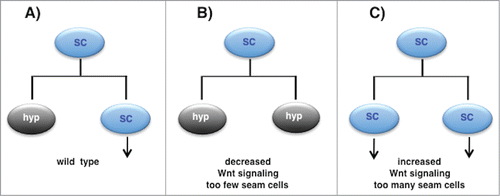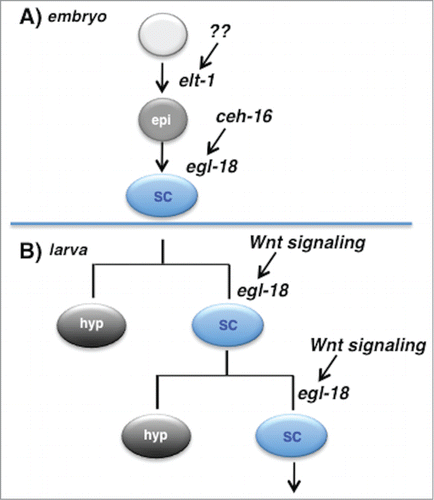Figures & data
Figure 1. Seam cell division pattern. (A) Diagram of a newly hatched L1 hermaphrodite larva showing the position of 10 seam cells along the lateral midline on the left side (anterior is left, dorsal is up). (B) Diagram showing the division pattern of a representative ‘V’ class seam cell. The seam cell is specified in the embryo but does not divide. During each larval stage the seam cell divides once along the anterior-posterior axis to generate an anterior daughter that differentiates (usually as a hypodermal cell ‘H’ that joins the syncytial hypodermis) and a posterior daughter that retains the seam cell fate and the ability to divide further (blue lineage). In the early L2 stage, the seam cell divides once in a symmetric manner to generate 2 seam daughters that subsequently only divide asymmetrically. After their division in the L4 stage, the seam cells themselves exit the cell cycle and fuse homotypically to form a long syncytial seam cell that secretes the adult cuticle alae (blue lines).

Figure 2. Wnt signaling regulates the asymmetry of the larval seam cell divisions. (A) In wild type animals, each seam cell divides once per larval stage to generate anterior hypodermal daughter (‘hyp’) that differentiates and a posterior daughter that maintains the seam cell fate (‘SC’) and the ability to divide further (vertical arrow). (B) When Wnt signaling pathway activity is reduced, seam cells are seen to divide symmetrically to generate 2 daughters that adopt the anterior ‘differentiated cell’ fate. (C) When Wnt signaling pathway activity is increased, seam cells are seen to divide symmetrically to generate 2 daughters that adopt the posterior 'progenitor cell' fate.

Figure 3. EGL-18 mediates seam cell fate specification in the embryo and larva downstream of different inputs. (A) During embryogenesis, cells in the AB lineage that are fated to become seam cells are first specified to adopt an epidermal fate (‘epi’) via action of the GATA factor ELT-1. Later, expression of CEH-16 in these cells leads to expression of the GATA factor EGL-18 (these cells also express the related GATA factor ELT-6, not shown), leading them to adopt the lateral hypodermal or seam cell fate (‘SC’). These cells do not divide until larval life begins. (B) In larval life, some seam cells divide asymmetrically to generate a posterior daughter that retains the seam cell fate and the ability to divide further. Maintenance of this progenitor cell fate requires activation of the Wnt signaling pathway to maintain expression of egl-18 in only that daughter cell of the division. Thus an embryonic fate specification factor is reutilized to maintain a progenitor cell population in larval life, and egl-18 specifies the seam cell fate both embryonically and post-embryonically, but in response to different input signals.

